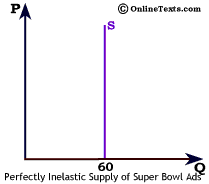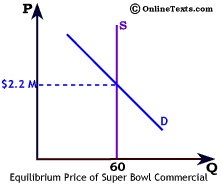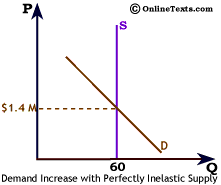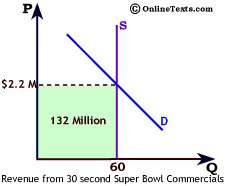
The big change this year is the concentration of dot-com companies advertising during the game, up from 3 last year to 17 this year. In fact, dot-com companies constitute over half of all the companies advertising during the game. This translates into a large shift up in the demand curve for commercial time during the Super Bowl.

The interaction of supply and demand, as we know, determines market price. The supply of commercial air-time for ads during a Super Bowl game is, essentially, perfectly inelastic. We show this graphically as a vertical supply curve, shown to the right, with 60 30-second commercial blocks the [Outside Econweb] ABC Network can sell for this game.

The demand curve, driven up by the dot-coms, intersects the supply curve such that the equilibrium price is at least $2.2 million per commercial, as shown to the left. Since the supply of the Super Bowl commercial spots is inelastic, rising demand can only increase price, not quantity. As we know, rising demand and inelastic supply always lead to rising prices and revenues.

The extra demand enabled ABC to charge some of the dot-com latelys prices above the already high 2.2 million. Thus, as shown to the right, the later demand curve drove the price up to an unheard of $3 million per 30 second spot, or $100,000 per second! The rapid run-up in market valuation of internet companies, and the enthusiasm of investors for many of these dot-com startups has left many flush with cash but with no name recognition. Some of these dot-coms are not just airing their first Super Bowl commercials, but their first TV commercials ever!
Will it turn out that these big gambles by new dot-com companies will pay off, or will it turn out that because so many dot-coms advertise that consumers will find the whole thing a big yawn? We can't say, but we can say that the economic phenomenon is both interesting, and illustrative of basic demand and supply principles.

The ABC Network will earn revenues of over 130 million dollars during Super Bowl XXXIV, shown as the green rectangle to the right (60 x 2.2 million = 132 million). Depending on how many spots were sold for 3 million, revenues could be significantly higher. As we know, revenues aren't the same as profit. In addition to direct production costs ABC must pay large licensing fees to air the game. Still, ABC will get to charge high prices on commercials shown during the long pre-game show too, so we can rest assured that it will be a super profitable day for them, whatever kind of day it is for the dot-coms. Oh, in case you're interested, there is also a football game being aired between commercials.
Copyright © 1995-2003 OnLineTexts.com, Inc. - All Rights Reserved